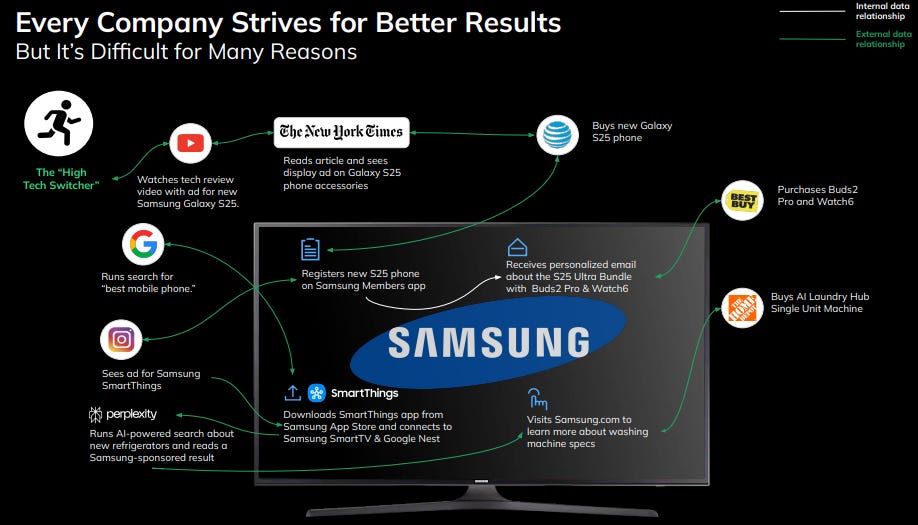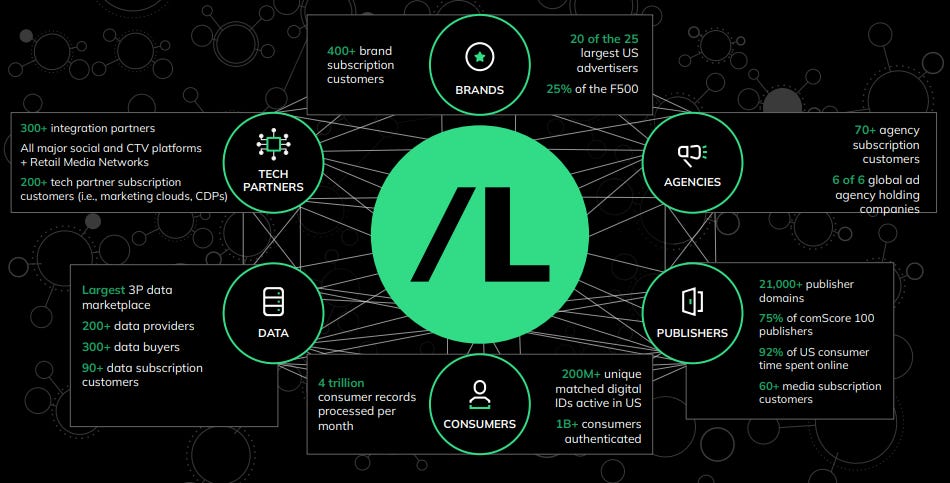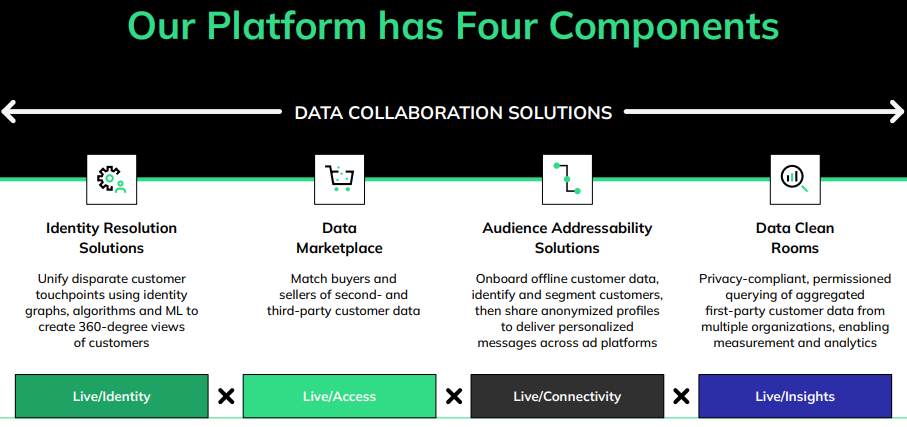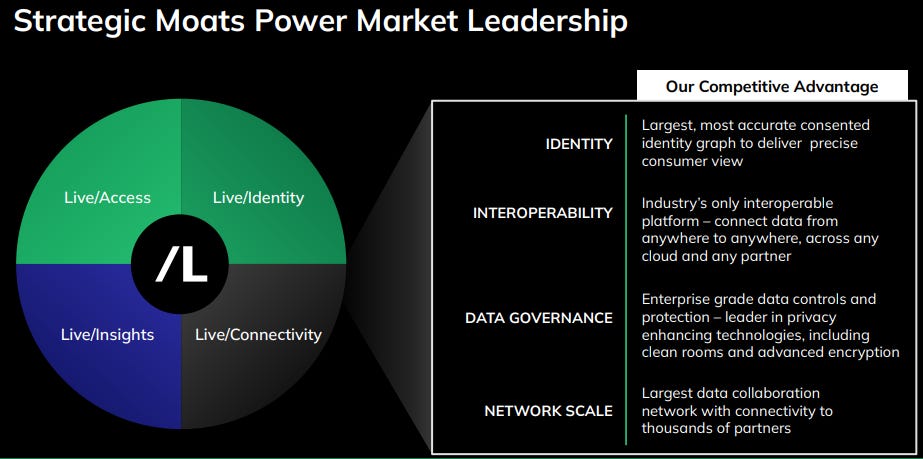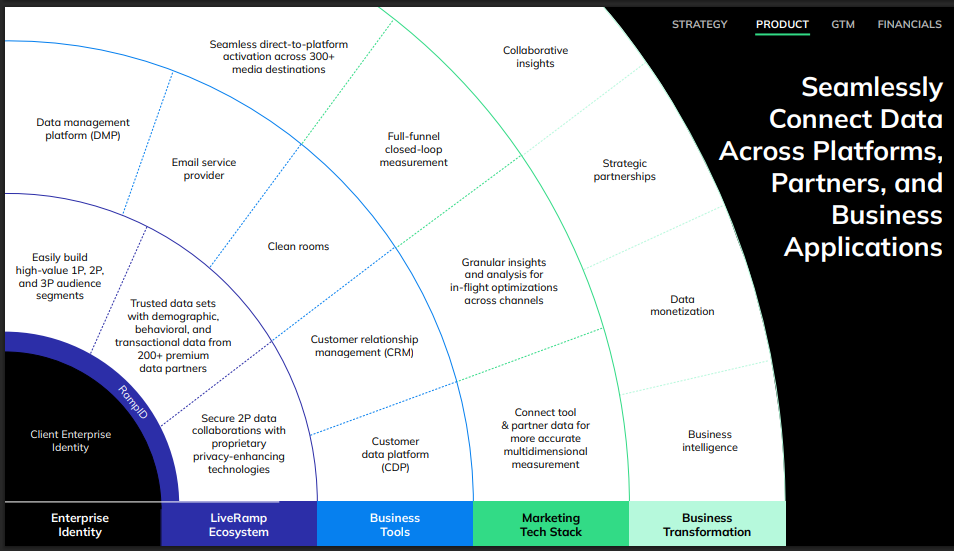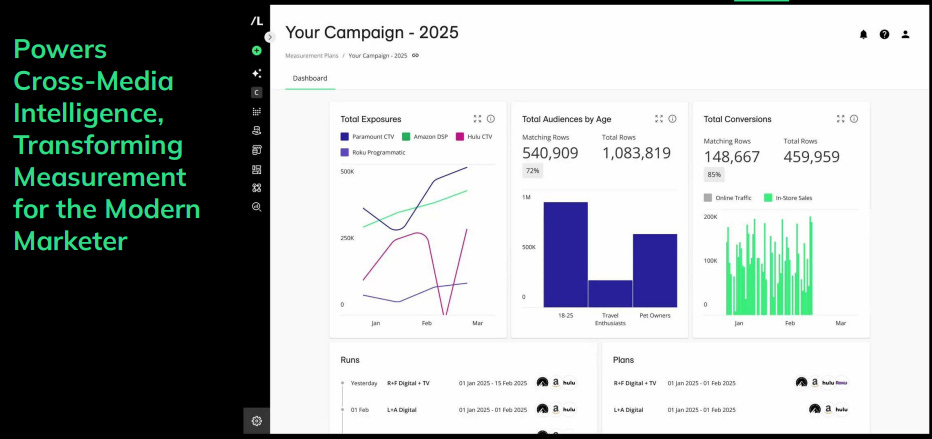Overview
LiveRamp Holdings, Inc. is recognized as a leading data collaboration technology company. The company's core mission is to empower marketers and media owners to deliver and measure marketing performance.
Technology & Function: LiveRamp operates a data collaboration network that seamlessly unites data across advertisers, platforms, publishers, data providers, and commerce media networks. It functions as middleware for the customer experience economy, making data consistent, consumable, and portable, and sitting between customer data and the thousands of applications powered by that data.
Foundation: The platform is built on a foundation of strict neutrality, interoperability, and global scale. LiveRamp is one of the only open and neutral data collaboration platforms operating at large scale.
Structure: LiveRamp is a Delaware corporation headquartered in San Francisco, California. Its common stock is listed on the New York Stock Exchange under the symbol “RAMP”. It serves a global customer base across the United States, Europe, and the Asia-Pacific (APAC) region.
Industry Dynamics
The industry is defined by the convergence of several key trends, particularly the move toward the customer experience economy, which demands personalized, relevant, and cohesive experiences across all channels.
Key Industry Drivers
Data Utilization: Organizations recognize that competitive advantage requires enhanced insights achieved through structured data collaboration, often combining first- and second-party data. Advances in AI/machine learning and connected devices have made it possible to process massive amounts of customer data.
Commerce Media: The advertising market is being transformed by commerce media, which links media impressions directly to sales transactions, necessitating safe and secure data collaboration built on shared first-party consumer data.
Major Challenges LiveRamp Addresses
Customer Journey Complexity: The explosion of channels and devices creates a highly fragmented technology landscape and forces companies to contend with data silos.
Fragmented Identity: Customer journeys span multiple channels and devices, meaning a single individual may appear as dozens of different identifiers (e.g., different email addresses, device IDs, or cookies), preventing companies from resolving all relevant data to a specific individual.
Marketing Inefficiency: Inaccurate consumer identification leads to billions of dollars in wasted marketing spend on irrelevant or mistimed messages.
Walled Gardens: These marketing platforms strictly control data use outside their walls, resulting in diminished control and transparency for brand advertisers.
Heightened Privacy and Security: Regulations such as GDPR and CCPA, along with a rapid growth in U.S. state-level privacy laws (at least 22 states expected by January 1, 2026), necessitate ongoing diligence and robust data governance.
Data Collaboration Platform
The platform enables responsible data collaboration by unlocking siloed and fragmented consumer data. It offers four core capabilities:
Live/Identity: Provides enterprise identity infrastructure using an omnichannel, deterministic identity resolution technology. It combines offline and online data graphs. Its digital identity graph, powered by the Authenticated Traffic Solution (ATS), links online customer IDs to a RampID™—a durable, privacy-centric connector.
Live/Access (Data Marketplace): Offers simplified access to industry-leading third-party data providers globally. This Marketplace works with more than 225 data providers and enables data buyers (brands, agencies, platforms, publishers) to access third-party data connected via RampID to enrich first-party data.
Live/Connectivity: Enables secure data matching through data onboarding, which ingests a customer’s first-party data, removes all Directly Identifiable Information (DII), and replaces it with a pseudonymized RampID. LiveRamp connects data across an ecosystem of more than 500 partners, one of the largest networks in the digital marketplace.
Live/Insights: Facilitates data collaboration using clean room technology for advanced measurement and analytics. This allows customers to securely combine disparate data files (e.g., ad exposure and sales transactions) using RampID to measure outcomes like cross-channel attribution and sales lift.
Revenue Model
Customer Base: LiveRamp works with 840 direct customers worldwide. It also serves thousands of additional customers indirectly through partners and resellers.
Customer Segments: Direct customers include many of the world's best-known brands across verticals like financial services, retail, automotive, media, and healthcare. Key customer types include Brands/Agencies (over 500 of the largest), Ad/MarTech Providers, Publishers, and Data Sellers.
Customer Growth: Customers typically grow their use of the platform over time. As of March 31, 2025, 128 customers had subscription contracts exceeding $1 million in annual revenue.
Revenue Generation:
Subscription: Approximately 76% of total revenue is derived from subscription-based arrangements, primarily charged annually based on data volume (data input records and connection points).
Marketplace and Other: Revenue is generated through revenue-sharing agreements with data sellers and transactional usage-based arrangements. Usage-based subscription revenue accounted for 15% of total subscription revenue in the twelve months ended March 31, 2024, and 2025.
R&D Spending: Research and development expense totaled $151.2 million in the twelve months ended March 31, 2024, and management expects to maintain similar spending levels (as a percentage of revenue) in fiscal 2026.
Seasonality: Data Marketplace and usage-based subscription revenue experience modest seasonality, typically tied to increased holiday advertising spend in the fourth calendar quarter.
Competitive Strengths
LiveRamp's strengths center on its identity capabilities, connectivity scale, and network effects:
Scale Leader in Data Connectivity: The platform processes more than 4 trillion data records daily and activates data across over 500 partners.
Advanced Recognition: Uses proprietary, patented recognition technology (AbiliTec® and deterministic digital matching) to link online and offline data with high accuracy and speed.
Neutrality: LiveRamp is uniquely neutral in the marketing ecosystem, enabling customers to build integrated marketing stacks using their preferred providers.
Data Stewardship: The company is a standard bearer in consumer privacy and data stewardship, operating a privacy-enabled environment and having dedicated privacy teams globally.
Growth Strategy
LiveRamp's growth strategy focuses on expanding its market presence, increasing platform usage, and deepening its technological leadership:
Customer Growth: Grow the direct customer base, targeting the estimated 2,000 marketers that represent a significant opportunity.
Increase Network Density: Employ a "land and expand" strategy based on usage expansion (as pricing is based on data volume). Focus on adding more data owner nodes, such as large CTV publishers and commerce media networks, to enable more robust measurement.
Channel Partnerships: Actively expand channel sales efforts with crucial partners, including customer data platforms (CDPs), public cloud providers, cloud data warehouses, and global systems integrators.
Identity Leadership: Intends to establish LiveRamp and the RampID as the standard for consumer-level recognition across the marketing ecosystem.
Market Expansion: Intends to expand its role inside the enterprise, moving beyond paid media advertising to power all customer experience use cases (e.g., call centers, supply chain management, email campaigns) and eventually pursuing adjacent markets like risk/fraud, healthcare, and government.
Global Expansion: Invest in expanding presence in select regions in Europe and APAC to serve global customers.
New Growth Initiatives
There are several recent growth initiatives:
CMI; Cross-Media Intelligence
CMN; Commerce Media Networks
CTV; Connected TV
Pricing Model Changes
Cross-Media Intelligence
LiveRamp's CMI (Cross-Media Intelligence) is a major product offering as of 2025, designed to provide marketers with a unified, deduplicated view of advertising campaign performance across all media channels, screens, and platforms.
By integrating data from publishers, demand-side platforms (DSPs), and various partners into the LiveRamp Data Collaboration Platform, CMI enables marketers to measure, analyze, and optimize media investments with much greater accuracy and granularity.
Key Features and Benefits
Unified, Deduplicated Reporting: CMI aggregates exposure data across linear TV, connected TV (CTV), digital, and other platforms to give marketers a complete, side-by-side view of campaign reach and performance, eliminating double-counting and data silos.
Actionable Measurement: The platform offers pre-configured templates, automated tools, and self-serve workflows, accelerating insights and reducing reporting times by up to 4x compared to legacy methods.
Customizable Reporting: Marketers can tailor campaign reporting to their own goals, optimizing creative strategies, audience selection, and spend allocation for improved ROI.
Clean Room Environment: CMI is built within LiveRamp’s privacy-centric clean room network, ensuring data security and compliance as multiple partners collaborate and unify datasets.
Rapid Optimization: The solution claims to boost actionability and ROI by up to 25% by enabling faster, granular decision-making across all media investments.
Industry Collaboration: LiveRamp’s extensive publisher and partner network means CMI users benefit from wide data coverage—up to 6x more than traditional methods—unlocking cross-channel, cross-partner analysis that was previously siloed or fragmented.
Use Case and Market Adoption
CMI is positioned as a next-generation answer for marketers seeking true omnichannel measurement, eliminating the need for outdated panels or piecemeal analytics, and is actively used by more than 30 notable media networks in LiveRamp’s ecosystem as of the 2025 launch.
Marketers can leverage CMI for campaign optimization, audience measurement, creative testing, and budget allocation—all with high-speed, privacy-safe insights.
Distinctiveness vs. Legacy Approaches
Unlike traditional panel-based measurement or fragmented reporting solutions, CMI provides a consolidated, deduped, and privacy-enhanced reporting engine, unlocking business value more quickly and effectively than prior approaches.
Commerce Media Networks
LiveRamp's Commerce Media Networks are a rapidly growing facet of digital advertising, enabling non-retail brands and publishers—such as financial services, travel, entertainment, and traditional retailers—to build their own media networks and monetize first-party data for targeted advertising.
As of 2025, LiveRamp is positioned as a data collaboration and clean room partner to many high-profile commerce media innovators, including Chase Media Solutions, Uber Ads, PayPal Ads, CVS Media Exchange, Albertsons Media Collective, and Western Union Media Network.
How Commerce Media Networks Work
First-Party Data Activation: These networks leverage deep, proprietary first-party data (such as past purchase history, transactional data, operational patterns) to enable precise audience targeting and attribution throughout the full advertising funnel, from awareness to conversion.
Closed-Loop Measurement: Brands and advertisers can measure the performance of campaigns across every touchpoint and channel, often using LiveRamp’s platform for privacy-centric, secure data collaboration, clean rooms, and unified reporting.
Monetization and Partnerships: Commerce media allows companies—retailers, banks, hospitality platforms, and more—to increase site/store traffic, boost incremental ad revenue, and deepen customer loyalty through partnerships and curated data offers.
Industry Expansion: While retail media remains dominant, LiveRamp's infrastructure is powering growth for a wide array of commerce networks outside traditional retail, helping companies create new revenue streams and collaborate securely with advertisers.
Featured Partners and Case Studies
Chase Media Solutions: Delivers full-funnel campaign visibility and lets marketers reach authenticated Chase audiences, with LiveRamp powering secure data flows and privacy protocols.
CVS Media Exchange: Showcases how advanced data collaboration enables innovative campaigns and measurable performance for healthcare and consumer brands.
Western Union Media Network: Connects multicultural audiences based on financial transaction data, lets advertisers run programmatic campaigns targeting authenticated segments, and measures omnichannel performance through LiveRamp’s tools.
Others: Brands like Lyft, Dick’s Sporting Goods, United Airlines, and Sam’s Club are leveraging LiveRamp’s media network capabilities to drive new customer experiences, stronger partnerships, and additional revenue.
Market Impact and Trends
Explosive Growth: Commerce media ad spending is projected to reach $118.4 billion in the US by 2029 (growing at 15%+ CAGR), with nearly one in four digital ad dollars spent in this channel by 2028.
Network Effect: LiveRamp’s position as a trusted data clean room and collaboration provider enables large-scale connectivity across publishers, platforms, and advertisers, driving efficiencies, measurement accuracy, and privacy for all partners.
Innovation Focus: Leading commerce media networks are using AI and advanced analytics (often through LiveRamp) to enhance product discovery, personalize campaigns, and improve full-funnel attribution.
CTV
LiveRamp is deeply invested in Connected TV (CTV) as one of its core growth verticals, offering solutions for identity resolution, secure data collaboration, and unified measurement across streaming platforms and traditional TV environments.
LiveRamp’s CTV efforts are driven by the need to solve audience fragmentation, deduplicate campaign reach, and enable more precise attribution—all through privacy-safe clean rooms and partnerships with top media and ad platforms.
CTV Product Features and Strategy
Identity Resolution for CTV: LiveRamp RampID enables trustworthy audience targeting by connecting first-party data across streaming platforms, content providers, and measurement partners. This allows accurate deduplication, cross-screen frequency management, and high-confidence outcome measurement.
Clean Room Solutions: LiveRamp’s clean room technology powers secure data collaboration between advertisers, publishers, and retailers, unlocking holistic campaign measurement and attribution across CTV, linear TV, digital, and even retail media.
Unified, Deduped Reporting: Marketers get real-time, unified reports spanning all screens, allowing them to analyze reach, frequency, conversions, and tie exposures to business outcomes―not just proxy metrics.
Multiple Attribution Methods: LiveRamp supports advanced attribution techniques (like combined MMM and multitouch models) to accurately assess CTV’s full-funnel impact, overcoming limitations of legacy approaches and data signal loss.
Key Partnerships and Adoption
AdOmni Partnership: LiveRamp and AdOmni deliver unified cross-media measurement, enabling campaign planning and optimization across CTV, online video, and digital out-of-home (DOOH), helping marketers understand cross-channel exposures and optimize their media mix.
Microsoft Advertising Integration: Expands clean room-based connectivity, enabling joint customers to seamlessly measure across Microsoft’s CTV and digital inventory with privacy and interoperability at the center.
NBCU, Roku, and Kroger: Use LiveRamp clean rooms to connect CTV viewership data to retail outcomes (through loyalty cards or transaction data), unlocking closed-loop measurement and actionable ROAS insights for advertisers.
CTV Market Trends and Impact
CTV ad spend in the US will top $30B in 2025 and is one of the fastest-growing major ad channels.
Advertisers are demanding better accountability from CTV than ever before, with LiveRamp recognized as a leading provider for cross-platform measurement and privacy-first data collaboration.
Data activation and collaboration for smarter CTV targeting is cited as a key driver for improved reach, engagement, and business results in streaming environments.
New Pricing Model
LiveRamp began piloting a new pricing model in mid-2025, designed to be simpler, more flexible, and usage-based rather than relying on its previous, more complex structure.
new approach introduces standardized pricing with usage “tokens” that are fungible across the full LiveRamp platform—allowing customers to use their token balance for any product or use case, instead of managing separate SKUs or billing metrics by product.
Key Elements of the 2025 Pricing Model
Usage-Based Tokens: Customers buy a pool of tokens that can be used on any LiveRamp product or feature, letting them shift usage as their needs change without renegotiating contracts.
Lower Entry Costs: The model lowers upfront costs to help attract mid-market and platform/data provider customers who may have been priced out by the legacy approach.
Faster Upsell and Expansion: Deal velocity is expected to increase as clients can start small and expand quickly with seamless access to new features or products, simply by using more tokens.
Operational Efficiency: The new model reduces internal complexity, trims the variety of billing SKUs, and automates reporting—yielding cost savings for both LiveRamp and clients.
Volume/Duration Discounts: Annual and multi-year commitments remain available, offering discounts to customers who lock in larger or longer-term purchases.
Rollout and Impact
The new tokenized, usage-based pricing framework launched as a pilot with up to 40 customers—including several large media brands—in mid-2025, with plans for broader rollout if initial feedback is positive.
Legacy pricing for enterprise accounts previously included custom quotes based on data volume, feature sets, integrations, and annual recurring revenue, often ranging from tens of thousands to hundreds of thousands USD per year.
The initiative aims to make LiveRamp's services more accessible to smaller buyers and align pricing directly with customer usage and cloud infrastructure costs.
Stay tuned for our upcoming Quick Take on LiveRamp, discussing the progress, financials, and prospects for the company.


